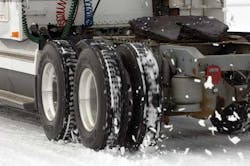Trends in the medium truck tire market come and go, but the drive to reduce rolling resistance levels is here to stay, says Donn Kramer, Goodyear Tire & Rubber Co. director of marketing for commercial tires.
This extends not only to steer and trailer tires but also to drive axle tires. That’s why more drive tires are rolling off the assembly line with closed shoulder tread designs, according to Kramer.
“Open shoulder designs, which may be more attractive in terms of performance, are worse on fuel economy. There are more voids in the tread so there’s less rubber in contact with the road. And there are generally more sipes. Those extra sipes hurt rolling resistance.”
In addition, open shoulder designs are more susceptible to uneven wear, which reduces tread life.
Kramer says 60% of a drive tire’s fuel economy is derived from tread elements. Other components, like compounding, make up the rest.
To reduce rolling resistance, “you have to change the dynamics of the tire’s lug elements, meaning they should be stiffer. The stiffer they are, the better it is for (lowering) rolling resistance. But you can’t get them too stiff because that won’t be as good for traction.”
Technologies exist to inter-lock tread lugs, he says. “And that’s what is happening with closed shoulder drive tires. You’re trying to stiffen the lug elements as the tire rolls through its footprint.”
Truck tire manufacturers also are switching to silica-based compounds, an effort that is being driven by government-mandated fuel economy requirements.
Major shift looming?
Kramer says the focus on reducing rolling resistance will continue as the government pushes for more fuel-efficient commercial trucks.
This past June, President Obama directed the U.S. Department of Transportation (DOT) and the U.S. Environmental Protection Agency (EPA) to boost the fuel efficiency of medium and heavy-duty trucks, starting with model year 2014 vehicles.
The DOT and EPA are developing rulemaking proposals to achieve the objective. A final rule will be issued next summer.
“If (fuel efficiency) standards similar to automobiles and light trucks go into effect for trucks at some point in the not-too-distant future, you’re going to see tremendous emphasis on trying to hit (low rolling resistance) targets,” says Kramer.
If fuel efficiency standards are set, original equipment truck manufacturers “will decide upon tire sizing and, to a greater extent, tread designs.”
Don’t forget casings -- They’re an important component, too
“A big part of drive tires is their casing construction and how many times a fleet can utilize that casing by retreading it,” says Chris Hoffman, manager, TBR and retread product marketing, Bridgestone Bandag Tire Solutions. “That’s pretty important as fleets try to keep their total operating costs low.”
All manufacturers, he says, want to design “a ‘super tire’ with the lowest rolling resistance and the longest tread wear, (but) there are different stresses put on a driven tire vs. a free-rolling tire.”
As tiremakers continue to develop new drive axle tires, “over time, you’re going to see changes in tread designs, you’re going to see changes in compounds, and you will see changes in casing construction, too.”



